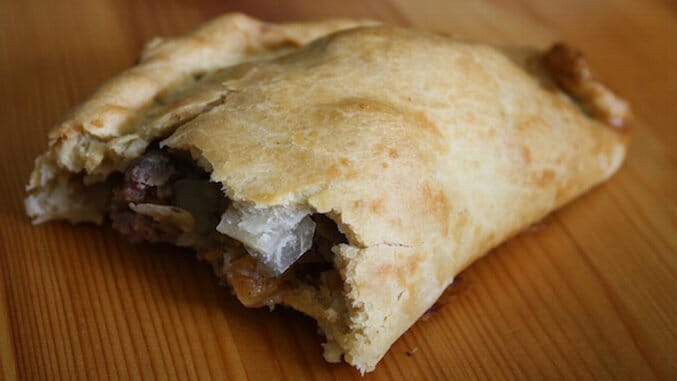
Oh, we in England with our bad teeth, crummy healthcare and perpetual rain. It’s made all the more unbearable by a meagre diet of black pudding and jellied eels. Why do Americans even bother to visit its malnourished, drizzly shores?
Firmly ingrained in the American psyche is the notion that British food is terrible. It’s a bit of a shame because, like America, England is evolving into a nation of food enthusiasts, much of it based on tradition. Yet many Americans carry this prejudice with them, applying it by default. The reality is that on both sides of the Atlantic we have good and bad, strange and commonplace.
The Second World War created a black hole in British kitchens. The Luftwaffe bombed the country to bits, while the German Navy blocked the import of goods. Pre-war Britain imported close to 70 percent of its food. The government implemented strict food rationing in 1940, and it wasn’t released until 1954. America had its own food rationing, of course, but it was nowhere near as crippling, lasting just four years. The USA was more self sufficient, and it took a different direction in the 50s – with the boom of processed, cheap fast food.
With a stalwart resolve and stiff upper lip, British people did what they did best — made do. Luxuries were rare; meat was scarce. Not that Britain was a culinary Mecca pre-war, but in those days of digging in, food was and transformed — boiled senseless or roasted to hell — into a stodgy brown mess that fed many. Rationing created a hangover that lasted past its 1954 cut-off, right through the 70s. Overcooked meat and two mushy veg were the result of a 14-year culinary reset. It coincided with the era of airliner-based Transatlantic tourism. Holidaying Americans were justifiably put off. But the label endured.
So, what is this superior cuisine that Americans tout? Mom’s apple pie, casserole, pot roast and meatloaf — the cornerstones of nutrition on the table of the American dream. Or, with the American passion for eating out, soul food, burgers, pizza and chilli-cheese fries. It seems a little unfair to sum up American food in just a few of its iconic dishes, let alone dismissing its melting-pot influence. Americans took beloved recipes from their heritage and made them their own. The features of the archetypal American menu are decked in a history beyond its 240 years.
The English were baking apple pies, roasting meat and making soups, stews and casseroles for centuries before America was even colonised. Indeed, apples were first brought to America from European stock. And the burger, an American creation? Technically, all sandwiches owe their name to the 4th Earl of Sandwich, who would like his meat between two bits of bread so he could hold it and continue to play cards. Though arguably, other cultures wrapped bread around food for thousands of years before that.
There are many similarities between English and American food. We eat much the same stuff: soups, stews, pies, casseroles, meat, fish, vegetables, starches, salads, dairy — baked, fried, boiled, broiled, grilled, braised and roasted. We both love a roast chicken dinner or a bacon sandwich. So what is the idea of English food that is entrenched in the American mindset? It seems to revolve around the oddities and differences.
Take the beloved pasty, a national treasure with its own unique history. A pasty’s peppery steak and vegetable filling is enveloped in a scrumptious blanket of pastry, folded over, calzone style, and baked. It was originally created as a meal in one for miners, the handle of crust utilitarian and, often, discarded. Despite differing versions existing all over the world, it is viewed as a trite example of U.K. cuisine by American tourists. Flavoursome steak, vegetables and pastry, wrapped in a handy snack … what is so elementally bad or strange about that?
Odd foods worm their way into all cultures, but it’s unfair to label the entire scene “disastrous” based on standouts. The aforementioned black pudding and jellied eels are go-to illustrations of the horrors lurking on English tables. Rocky Mountain oysters and chitterlings seem equally gross. (That’s before you get to sweet potatoes with marshmallows, or jello salad.) In much the same way that not everyone in England eats black pudding, not everyone in America exists on a diet of deep-fried testicles and grits.
We have a couple of other things in common. And these ones are unfortunate. Firstly, as cultures, we are not very adventurous when it comes to our food. We still prefer, en masse, what is familiar, tasteless even — food is for fuel; not for pleasure. Both the U.S. and the U.K. have come a long way in terms of embracing international foods and broadening perspectives, but sadly, many of us still want what is predictable and, ultimately, comfortable.
England and America are laden with restaurants that cater to the plain eating. British people have marvelled at tasteless, greasy Southern cooking. Likewise, Americans have found pub meals bland and unappealing. The second point is that good and bad food exists on both sides of the ocean. Some soul-food joints are spectacular. Find the right pub with a passionate landlord, and the food can be exceptional. If you go to London with the mindset that English food is awful, and then you eat in lazy, unenthusiastic places, you’re bound to have something foul.
When the entire food of a nation is tarred with a judgmental, all-encompassing brush, it seems a little sad. It’s a wasted trip when you are bound by generalized conceptions and a disregard for cultural differences. The American misconception of English food was catapulted by circumstance and remains unfortunately obtuse. With that mindset it becomes very easy to forget that all food has a history, and it is truly international. We offer something important to each other, the world over — and we always have.